Computer and how it works message. How does the computer
The objectives of the lesson.
Educational:to acquaint students with the computer device, its main and additional devices, to expand vocabulary.
Developmental:development of cognitive interests, self-control, skills of working with an interactive whiteboard, mouse and keyboard.
Educational:education of information culture of students, attentiveness, accuracy, discipline, perseverance.
introduce concepts of basic and additional computer devices;
to consolidate what was learned with the help of exercises and a test.
Type of lesson: combined.
Equipment: interactive board, multimedia projector, computer, computer presentation ( MS PowerPoint), exercises made using the program Starboard, test (Internet Explorer).
The structure of the lesson.
Organizational moment - 2 min.
Explanation of the new material - 20 min.
Consolidation of the material studied - 15 min.
Homework - 1 min.
Summing up - 2 min.
Time reserve.
DURING THE CLASSES
1. Organizational moment (2 min).
Greetings from teachers and students. Test the readiness of students for the lesson.
2. Explanation of a new material (20 min).
The lesson is accompanied by a presentation: "How is the computer?"
Do you guys read the poem and think about which word is missing?
Look around, buddy, around!
Here ... - a true friend.
He will always help you:
He will indicate an error
Photos and movies will show.
He will play a game with you,
And you will not be bored !!!
Right guys, this is a computer!
Computer... everyone knows this word, even those who are not familiar with informatics.
What is a computer?
Computer - is an electronic device designed to receive, process, store and transmit information.
Our task is to study the computer device and its principle of operation.
Computers may have different external devices, but there are four types of devices that each computer has. it keyboard, mouse, monitorand system unit.They make up basic computer configuration.
Basic computer configuration - the minimum set of hardware sufficient to start working with a computer: keyboard, mouse, monitor, system unit.
The main thing in the computer is system unit.
System unit - The main unit of the computer system. It houses devices that are considered internal. Devices connecting to system block outside are considered external.
The system unit includes a processor, memory, hard and floppy disk drives, optical drives, a power supply, a motherboard, and some other devices.
CPU - the main unit of the system unit. Designed for computing, information processing and computer control.
I am the wisest of all
Even children know this.
Without my advice important
And making so brave
So I tell you, my friends,
There is no way to do it.
I help everyone a lot
All control is exercised
I combine the word with the deed
And reasonable govern.
The processor is located on motherboard. It provides communication between devices. On the system board there are: connectors for connecting devices, a bus for transmitting signals between devices, a chipset for monitoring.
Computer memory, as well as the memory of a person is designed to store information.
Will consider human memory: we remember your favorite poems, rules, ways of cooking and much more. All this we store in our memory - in the head - is inner memory, but all this information can be stored in a notebook - external memory.
Same with computer memory: it happens internal and external.
Internal memory is of two types: operational and constant. The devices that implement them are called Ram - random access memory and ROM - permanent storage device.
AT ROM instructions are stored that determine how to operate when the computer is turned on. These instructions not deleted even when you turn off the computer.
All programs and data necessary for the operation of the computer are placed in Ram. The processor can instantly access information in memory. After disconnecting the power source, all the information contained in the RAM, is lost.
For long-term storage of information is used long-term memory: hard and floppy magnetic disks, optical disks, flash memory.
Magnetic disks - These are round discs of plastic or metal, covered with a magnetic substance. Magnetic disks are tough and flexible.
Hard drives Large capacity built into the system unit and reside there. In the system unit there are also floppy disk drives - floppy disk. The diskette is manually inserted into the drive through a special hole in the case of the system unit. With the help of diskettes information can be transferred from one computer to another.
Recently, widespread optical discs.To read and write information from laser discs use a drive (CD-ROM, CD-RW, DV-RW) and flash memory.
Monitor created for output character and graphic information on the screen.
Keyboardit is applied for input information in the computer's memory by pressing keys.
Be extremely careful
It's hard to work with me.
Need skills to have
To master me
How many characters and letters
Runs away from under the arms
Just lightly touch
Look at the monitor,
Though you can make a mistake
And the conversation is interrupted.
Mouse -device "graphic" control, input. It dramatically facilitates the management process.
In the zoo there is a bunny,
The computer has a mouse
This mouse is not simple,
This mouse is like this:
Modest gray box,
Long thin wiring,
Well, on the box -
Two or three buttons.
For the mouse, as a rule, a special pad is used for more reliable contact with the mouse ball when moving it around the table. Moving the mouse on the screen pad moves mouse pointerwith which you can point to objects and / or select them.
There are mice mechanical and optical. Modern mouse models can be wirelessi.e. Connecting to a computer without a cable.
Fizkultminutka.
Physical exercise consists of two parts - from exercises for the prevention of visual fatigue and general exposure.
We did a good job, and it is time to take a rest and do a physical exercise-minute.
Please stand at your desks and repeat the movements behind me.
The song "Charging for the tail" from the cartoon "38 parrots" sounds.
Step on the left, right,
One and two, one and two!
Keep your back straight,
One and two! One and two!
And do not look at your feet,
One and two! One and two!
Once - sat down, two - stood up.
Hands up all raised.
And now in front of you,
Sat down, stand up, stand up.
Vanka - vstavkoy like steel.
One two, one two,
It's time to deal with us!
Take your seats!
Explanation of a new material (continued).
You can connect to the PC and additional devices: peripherals - devices intended for input and output information.
Consider some of them:
Output devices.
Printer serves for output information on paper media (paper). There are three types of printers: dot matrix, inkjet, laser.
For output complex and large-scale graphic objects (posters, drawings, etc.) use special output devices - plotters (plotters).
Acoustic speakers and headphones intended for output sound information.
Input Devices.
Scanners and graphic tabletsserve to automatically input texts and graphics in the computer.
For input sound information is used microphone.
To control the computer during the game you need joystick - device input.
There are other devices. They all make up computer hardware.
3. Fastening the material covered (15 min)
I came up with several tests for you that we will perform on an interactive whiteboard.
Task number 1.
From the proposed devices, assemble the basic configuration of the computer.
(One student comes to the interactive whiteboard and performs the task, the other students help him).
Task number 2.
Arrange the pictures of the devices in the desired columns.
(Two students take turns to the interactive whiteboard and fill in one column, the rest help).
Task number 3.
Combine the terms in the left column with their description in the right column.
(Students take turns to the interactive whiteboard and connect one term with a description, the rest help).
4. Homework (1 min).
§ 2.1 in textbook, exercises 1.2 pp. 54-55 in workbook.
5. Summing up (2 min).
What topic did we meet today?
What are the main parts of the computer?
What is the name of the information processing device?
What do you know storage devices?
What devices are called peripheral?
The children who are the most active and attentive in the lesson are given marks.
Time reserve
Computer testing on the subject of "How does a computer" - see the archive
Thank you for the lesson. Goodbye.
Lecture number 3 (2 hours)
How does the computer
The main blocks. Usually PCs consist of three parts:
- System block
- The keyboard allows you to enter characters into the computer.
- Monitor (display) - for the image of texts and graphic information.
Computers are also produced in a portable version - usually in a notebook version (laptop). Here, the system unit, monitor and keyboard, are enclosed in one case: the system unit is hidden under the keyboard, and the monitor is made as a lid to the keyboard.
System unit.Although of these parts of the computer system unit looks the least impressive, it is he who is the “main” in the computer. It contains all the main components of the computer:
· Electronic circuitscontrolling the operation of the computer (microprocessor, RAM, device controllers, etc.)
· Power Supplywhich converts the power supply of the network into a low-voltage direct current supplied to the electronic circuits of the computer.
· Drives (drives) for floppy disksused to read and write floppy disks.
· Hard Disk Drivedesigned to read and write to a non-removable hard disk (hard drive).
· Other devices.
Additional devices.
You can connect various input / output devices to the computer system unit, thereby expanding its functionality.
External devices.Many devices are located outside the computer system unit and are connected to it through special sockets (connectors), usually located on the back wall of the system unit. Such devices are usually called external. In addition to the monitor and keyboard, such devices are.
· Printer — for printing graphic and textual information.
· Mouse - a device that facilitates the entry of information into the computer.
· Joystick - a manipulator in the form of a knob mounted on a hinge with a button, used mainly for computer games;
· As well as other devices.
Internal devices. Some devices can be inserted inside the system unit, so they are called internal, for example:
· Modem or fax modem — to exchange information with other computers via the telephone network (the fax modem can also receive and receive faxes).
· CD-ROM drive, it provides the ability to read data from computer CDs and play audio CDs
· Streamer - for storing data on magnetic tape
· Sound card - to play and record sounds (music, voice, etc.)
However, modems, fax modems, streamers and other devices can be produced externally. As a rule, in-house devices are cheaper - they do not need to make a case and they do not need to be supplied with their own power supply.
Controllers and devices.To control the operation of devices in the computer uses electronic circuits - controllers. Different devices use different ways connections to controllers:
1. Floppy disk drive, keyboard, etc. connects to standard controllers in the computer;
2. Sound cards, many fax modems, etc. are made as electronic boards, i.e. mounted on the same board with its controller;
3. The remaining devices use the following connection method: an electronic card (controller) is inserted into the computer’s system unit that controls the operation of the device, and the device itself is connected to this card with a cable.
Microprocessor and coprocessor.
Microprocessor. The most important element in a computer, its “brain”, is a microprocessor - a small (several centimeters) electronic circuit that performs all calculations and information processing. The microprocessor can perform hundreds of different operations and does it at a speed of several tens or even hundreds of millions of operations per second. Microprocessors in ascending order of performance and price: Intel -8088, 80286, 80386 (modifications SX and DX), 80486 (modifications SX, SX 2, DX, DX 2 and DX 4), Pentium, Pentium Pro (3,4).
Clock frequency.The clock frequency indicates the speed of the elementary operations inside the microprocessor. Different microprocessor modems perform the same commands (for example, addition or multiplication) for a different number of cycles. The more modern the microprocessor model is, the less the microprocessor is usually required to execute commands.
Coprocessor.In cases when a computer has to perform a lot of mathematical calculations (for example, in engineering calculations, processing three-dimensional images, etc.), it is desirable that mathematical operations on real numbers are supported by hardware, i.e. by the microprocessor itself. But microprocessors do not provide such support, so they need to add a math coprocessor to them, which helps the main microprocessor to perform mathematical operations on real numbers. The newest microprocessors (Pentium) themselves are able to perform operations on real numbers, so no coprocessors are required for them.
Memory.
RAM. A very important element of the computer is the RAM. It is from it that the processor takes the programs and input data for processing, it writes the results into it. This memory has received the name “operational” because it works very quickly, so the processor practically does not have to wait when reading data from memory or writing to memory. However, the data contained in it is saved only while the computer is turned on. When you turn off the computer, the contents of the RAM are erased (with some exceptions). Often for RAM use the designation RAM (random access memory, ie, random access memory). The amount of RAM installed in the computer directly depends on which programs you can use on it. With an insufficient amount of RAM, many programs will either not work at all or will begin to work extremely slowly.
Cache memory To speed up access to RAM on high-speed computers, a special ultra-fast cache memory is used, which is located between the microprocessor and RAM and stores copies of the most frequently used sections of RAM. When the microprocessor accesses the memory, it first searches for the necessary data in the cache memory. Since the access time to the cache memory is several times less than that to conventional memory, and in most cases the data required by the microprocessor is already contained in the cache memory, the average memory access time is reduced.
Bios (permanent memory).In computers there is also a permanent memory, in which the data are recorded during its manufacture. As a rule, this data cannot be changed, programs running on a computer can only read them. This type of memory is usually called ROM (read only memory, or read-only memory), or ROM (read-only memory). The permanent memory stores programs for checking computer hardware, initiating the boot of the OS, and performing basic functions for servicing computer devices. Since most of these programs are related to I / O services, often the contents of permanent memory are called BIOS (basic input - output system, or basic input / output system). The BIOS also contains a computer configuration setup program (SETUP). It allows you to set some characteristics of computer devices (video controller types, hard disks and floppy disk drives, often also operating modes with RAM, a password request during initial boot, etc.). Typically, the configuration program is invoked if the user presses a certain key or key combination during boot.
CMOS (semi-permanent memory).In addition to the usual RAM and permanent memory, there is also a small memory area in the computer for storing computer settings and configurations. It is often referred to as CMOS memory, since this memory is performed using CMOS technology (complementary metal-oxide semiconductor), which has low power consumption. The contents of the CMOS memory do not change when the computer is turned off, since a special battery is used to power it.
Video MemoryAnother type of memory in computers is video memory, i.e. the memory used to store the image displayed on the monitor screen. This memory is usually included in the video controller - an electronic circuit that controls the display of the image on the screen.
Electronic boards, controllers and buses
Electronic cards.PC electronic filling is usually performed from several modules - electronic boards. Each board is a flat piece of plastic on which electronic components are fixed (chips, capacitors, etc.) and various connectors. Inside the electronic board, wires are laid to connect the components mounted on the board to each other.
Motherboard.The largest electronic board in a computer is a system board, or a motherboard. It is usually located the main microprocessor, RAM, cache memory, bus and BIOS. In addition, there are electronic circuits (controllers) that control some computer devices. So, the keyboard controller is always on the motherboard. Often, there are also controllers for other devices (hard drives, floppy drives, etc.).
Controllers.Electronic circuits that control various devices on a computer are called controllers. All computers have controllers to control the keyboard, monitor, drives, hard disk, etc.
Integrated controllers.In modern computers, many controllers are part of motherboard. Such controllers are called embedded or integrated. So, the keyboard controller is always embedded. Modern motherboards usually have floppy disk controllers, I / O ports, a hard disk controller, and sometimes a video controller.
Controller boards. Different users in the computer need a different set of controllers. Therefore, all computer controllers are embedded in the motherboard only in some special computers. In most computers, some controllers are located on separate electronic boards - controller boards. These boards are inserted into special connectors ( slots) on the computer's motherboard.
By adding and replacing controller boards, the user can modify the computer, expanding its capabilities and customizing it to fit its needs. For example, a user can add a fax modem, a sound card, a TV program receiving board, etc. to a computer.
Tires.When inserted into the motherboard connector, the controller is connected to the bus - the data transmission line between the RAM and the controllers. Modern computers usually have two tires:
- ISA bus for low-speed device controllers (i.e., for exchanging data with a keyboard, mouse, disk drive, modem, sound card etc.)
- PCI bus for exchanging data with high-speed devices (hard drives, video controller, etc.)
Older computers may have other buses - EISA, VESA (VLB), etc. However, to ensure compatibility, even modern servers local networks usually equipped with an EISA bus.
Tire connectors.Each controller can only be connected to the bus for which it is designed. Therefore, the connectors of different tires are made different so that they cannot be confused. When buying controllers, you should know which bus connectors are in your computer, because otherwise the controller will be useless.
I / O port controllers.One of the controllers that are present in almost every computer is the I / O port controller. Often this controller is integrated into the motherboard. The I / O port controller connects cables to connectors on the back of the computer through which a printer, a mouse, and some other devices are connected to the computer. I / O ports are of the following types:
- Parallel (denoted LPT 1 - LPT 4). Printers are usually connected to the corresponding connectors on the back of the computer (having 25 sockets).
- Consecutive(denoted by COM 1 - COM 3). The corresponding connectors on the back of the computer (with 9 or 25 pins) are usually connected with a mouse, modem, and other devices.
- Game port.A joystick is connected to its connector (having 15 sockets). Not all computers have a game port.
Typically, a computer's port controller supports one parallel and two serial ports.
Bus connectorsUSB. Computers have Universal Serial Bus USB connectors. Apparently, models of keyboards, mice, printers, modems, drives, scanners, etc., connected to the USB bus will be released soon. In this case, with each device connected to the USB bus, you can connect other USB devices (a total of up to 127 devices can be connected). USB device can be connected and disconnected while the computer is running. Perhaps in the near future, computers will have only two or three small USB connectors instead of keyboard, port and joystick connectors
Computer - this is not a novelty for anyone. Here he stands on the table in front of you, he blinks lights, gleams the screen, buzzes with something somewhere under the table. To start exploring this useful, but very incomprehensible machine, you must first understand how the computer works. This article will look at those parts of the familiar to all desktop computerthat we see. it system unit and so-called peripherals.
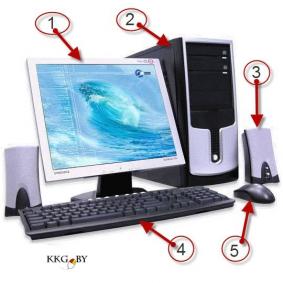
The text will refer to devices labeled with numbers in the figure to the left. Each picture can be enlarged by clicking on it with the left mouse button.
So let's start in order. And of course from the most important. Look around and find around you a big box that is on your table or under the table, usually in an upright position - this system unit (2). Do not confuse it with processoras some do, the processor is inside system unitlike many others important devices. What is a processor and what is inside the system unit (that is, internal devices) you will first see in a separate article (read about the device of the system unit). So far it is important to know that in system blockis all the power of the computer, the devices that are there just process the information and ensure the work external devices (peripherals).
Continue to inspect the computer. Please note that all external devices connect to the system unit. Let's take a brief overview (each device requires a separate article) and see what function they perform and what they are.
I want to draw your attention to the fact that I will not spend time on the technical structure of certain things. Important learn to work with them. The most important things I will explain in the process of exploring these devices, but for now the main thing own the terms and have a concept.
Computer device: monitor.
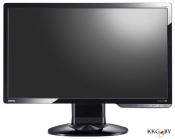 So, right in front of you is monitor (1). It performs the function of displaying information on the screen, which allows you to perceive it visually. The most common types of monitors are CRTs - they are designed on the basis of a cathode ray tube (CRT) LCD - liquid crystal monitors (English liquid crystal display, LCD) and plasma - based on a plasma panel
So, right in front of you is monitor (1). It performs the function of displaying information on the screen, which allows you to perceive it visually. The most common types of monitors are CRTs - they are designed on the basis of a cathode ray tube (CRT) LCD - liquid crystal monitors (English liquid crystal display, LCD) and plasma - based on a plasma panel
Computer device: speaker system.
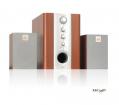 (speakers). This device is a sound output, through which we can enjoy your favorite music, movies, chat over the Internet. May have a different number of speakers. The sound quality depends on what material the body is made of and how powerful the speakers are.
(speakers). This device is a sound output, through which we can enjoy your favorite music, movies, chat over the Internet. May have a different number of speakers. The sound quality depends on what material the body is made of and how powerful the speakers are.
Computer device: keyboard.
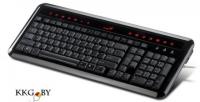 - input device. Using the keyboard, you can not only enter text, but also enter commands and control the position of the cursor. Most of the time you have to work with the keyboard. Try to disconnect it and immediately feel the inconvenience, but there are some tricks that can make life easier when there is no keyboard or it is broken, but more about that later.
- input device. Using the keyboard, you can not only enter text, but also enter commands and control the position of the cursor. Most of the time you have to work with the keyboard. Try to disconnect it and immediately feel the inconvenience, but there are some tricks that can make life easier when there is no keyboard or it is broken, but more about that later.
Computer device: mouse.
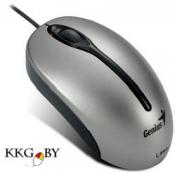 Mouse (5) - device-manipulator. Typically, a standard computer mouse has left and right keys and a scroll wheel between them. The mouse is controlled by moving it left or right, and the position of the cursor on the screen changes accordingly. The right mouse button is used mainly for calling up a menu, and the left one for selecting operations, starting programs, etc. However, for left-handers, these functions can be easily reversed. Keystrokes are often referred to as click or click. The wheel is used to scroll up and down, sometimes it can be pressed and this also corresponds to a specific function. Of course, the mouse may have additional keys. They are configured separately, later I will show a separate article on the example of my office mouse how to do it. May be wired and wireless, opto-mechanical (on the back of the mouse is a ball - such mice are almost out of date) and optical (mouse movement tracks the light beam - note that it burns under the mouse if you have an optical mouse)
Mouse (5) - device-manipulator. Typically, a standard computer mouse has left and right keys and a scroll wheel between them. The mouse is controlled by moving it left or right, and the position of the cursor on the screen changes accordingly. The right mouse button is used mainly for calling up a menu, and the left one for selecting operations, starting programs, etc. However, for left-handers, these functions can be easily reversed. Keystrokes are often referred to as click or click. The wheel is used to scroll up and down, sometimes it can be pressed and this also corresponds to a specific function. Of course, the mouse may have additional keys. They are configured separately, later I will show a separate article on the example of my office mouse how to do it. May be wired and wireless, opto-mechanical (on the back of the mouse is a ball - such mice are almost out of date) and optical (mouse movement tracks the light beam - note that it burns under the mouse if you have an optical mouse)
Computer device: printer.
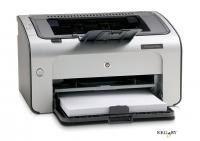 - A device that displays information to print. The printed text is still perceived even easier than on the monitor screen, right? As a rule, requires additional driver installation.
- A device that displays information to print. The printed text is still perceived even easier than on the monitor screen, right? As a rule, requires additional driver installation.
Subdivided into:
- matrix. The slowest and noisiest, printing is done by hitting the needles on the ink ribbon — a point is obtained. An image is formed from dots. Although matrix printers were faster than some modern inkjet and inexpensive, but too noisy. Many of you can see and hear their work in the bank branch.
- jet. Printing is done by spraying ink through small nozzles from the ink bottle, where they are under pressure. The small size of the droplets allows you to get a clear image. Of the minuses it can be noted that the print speed is slow, the ink consumption is quite large (so you have to change or refill the cartridge where the ink is located)
laser. On a special roller, charged areas are formed by a laser, where the coloring powder is attracted. The paper is rolled, the powder melts and hardens. They work very quickly and very quietly, but the cost is higher than that of a jet, especially a color laser printer.
Computer device: scanner.
 is an input device. Allows you to get a picture of a document or photo. Often this allows you to simplify life, since scanned document can be converted to a document that can already be edited. Or you can just send by e-mail or save to flash drive.
is an input device. Allows you to get a picture of a document or photo. Often this allows you to simplify life, since scanned document can be converted to a document that can already be edited. Or you can just send by e-mail or save to flash drive.
Computer device: MFP ("combine").
("combine" in common). Functions as a scanner and printer. Simultaneously for photocopy or separately. Convenient to save space, because the printer and scanner separately will still take up more space. However, as a rule, for the same price, you can buy both a printer and a scanner of better quality, but at a lower price.
Computer device: USB flash drive (USB flash drive).
In p 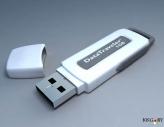 growth and Usb flash drive "by passport". it
growth and Usb flash drive "by passport". it 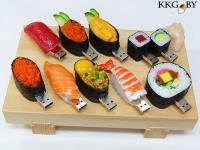 Memory device. Allows you to store and transfer information to today in very large volumes. A flash drive is very indispensable for these purposes, as it has a small size (with a little finger or even a fingernail) and can always be with you as a key ring (and the shape and size of flash drives is just a lot, you can find a flash drive in the form of sushi or bullet, for example ) until you need to connect it to a computer or other device. Connection is made through the so-called USB-port, which you will get acquainted with in the article where the system unit is considered.
Memory device. Allows you to store and transfer information to today in very large volumes. A flash drive is very indispensable for these purposes, as it has a small size (with a little finger or even a fingernail) and can always be with you as a key ring (and the shape and size of flash drives is just a lot, you can find a flash drive in the form of sushi or bullet, for example ) until you need to connect it to a computer or other device. Connection is made through the so-called USB-port, which you will get acquainted with in the article where the system unit is considered.
Computer device: webcam.
Another input device. This is a small camera designed primarily for communication using video on the Internet. Naturally, it can be used to record video, take a photo, but it will not work without a computer and the corresponding programs, that is, you will not be able to take it and go to shoot on the street, as is done with a regular camera.
Computer device: microphone.
Audio input device. Used for voice communication, voice recording, there are also special programs that allow give voice to computer commands or allow to recognize and translate into the text the dictated information.
Computer device: headset.
The combination of headphones and microphone, mounted on the head.
Very handy thing to communicate on the Internet.
Computer device: joystick.
The input device is a knob with buttons. Used mainly in computer games. You can find gaming devices of various types, for example, a steering wheel as in a car (respectively for games in the genre of racing simulators) or even an aircraft steering wheel.
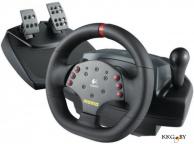
Many devices can be connected to the computer. Headphones, digital photo and video cameras were not considered separately. mobile devices and many many others. Much of this will be discussed in the relevant articles. I hope that the general concepts are clear and there is an idea of the main computer devices.
So, from this article you have learned:
- types of external devices and their purpose
how does a desktop computer
